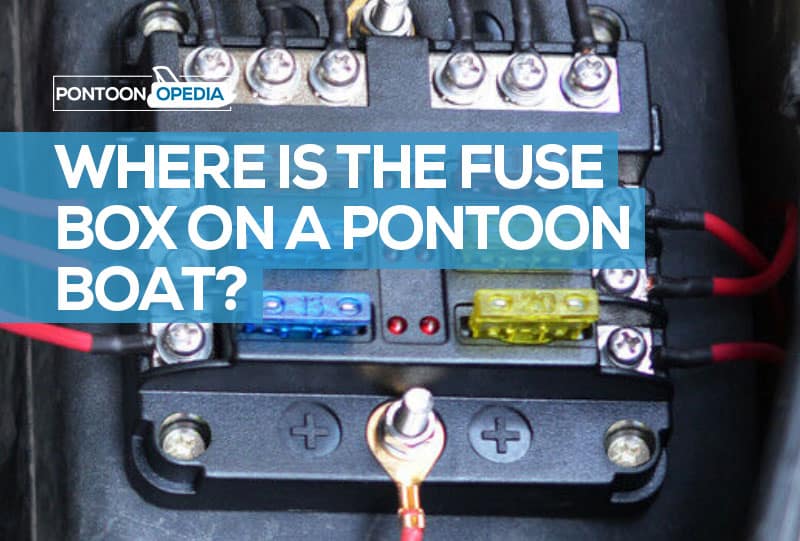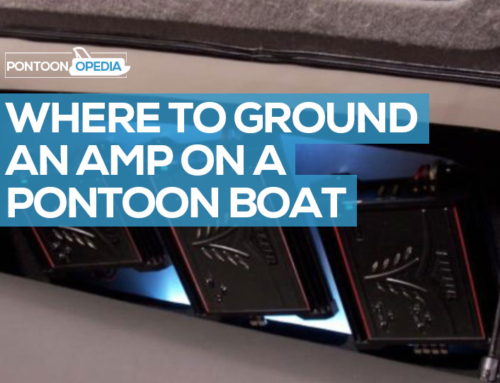A pontoon boat has a delicate fuse box and wiring system that can mean sweet relief from the heat or sheer anger when it isn’t working correctly. Not every pontoon boat will have a typical fuse box, but all will have a control panel where the electronics are controlled.
Where is the fuse box on a pontoon boat? The location is typically underneath the seats or main console panel. If you have an older pontoon, it will resemble the fuse box in your home. On the boat, it could be a small box or a large assortment of wires.
Tackling the fuse systems on a pontoon boat can be a headache inside a nightmare, but there is no need to lose sleep over it. Below you’ll learn the best ways to service your pontoon boat fuse box and electrical system.
Table of Contents
Pontoon boat fuse box locations
The best place to begin searching for the location of the fuse box is the owner’s manual. Inside the pages of the manual, you will find many essential things about your boat, like:
- What kind of fuses it needs
- How much power it generates
- How to troubleshoot electrical problems
Today, most boat owners have shunned the large fuse consoles that came in the 80s and 90s. A fuse box, or fuse block depending on the boat maker, connects the electronics aboard your boat to the power source, the battery.
Once the wiring is run to the battery, a set of switches will section it off from the circuit breaker. When a boat is in the dock, the power is cut completely to conserve energy.
It must be a heavy-duty box that can withstand the assault that being on the water can give. For this reason, and aesthetics, a popular trend is to place the board on the back of an exposed instrument panel.
A bonus of having the group hidden behind the wall is its proximity to the water. If a tiny wire becomes electrified inside the boat and is coated with water, all the passengers could be in danger of electrocution.
Automotive wiring has been bred into pontoon boating motors for an easier transition for mechanics. The shift has made the central instrument console the home for any electronics running on the boat. Your boat might not have a pontoon boat ‘fuse box’ to speak of. It will have a series of toggle switches that control the flow from the batteries, and these could have fuses and circuit breakers attached.
How to replace the fuses in a pontoon boat fuse box
If you have an older pontoon boat, there’s a chance you may be in a bind looking for fuses. They used a C-series-toggle-type part that is becoming more uncommon as time passes. The newer boat types use the ATC fuse, the kind that your car uses.
The switch to more modern fuses makes them more readily available and more accessible to find someone to work on them.
Depending on what kind of fuse box you have, there could be more or fewer steps. An older box will require the most work because the fuses are harder to source and can be a pain to install. The steps to replace a fuse in your pontoon boat fuse box are:
1.Locate the problem
Now that you know where the pontoon boat fuse box is, you can get in there and swap out all the fuses that have gone bad. If you have an older fuse box, like the one in older homes, you should check the fuses for a broken filament on the inside. They’re kind of like the ones you find in older light bulbs.
In the newer fuse, there will be a tiny window to show you if the filament has broken. It is usually below the prongs and above the base on the fuse body. The smaller fuses are easier to find. Upgrades can be made to ditch fuses all together and move towards a toggle system.
2. Use the pliers
Once you have figured out which fuse needs to be replaced, it is time to take it out. Grab a set of needle-nose pliers and gently tug on the edges of the fuse. It should come right out, but if it doesn’t, don’t be afraid to use some leverage to separate it.
If you have the round screw-in fuses, you will need a broader set of pliers. These old fuses have a knack for going or coming out crooked. Take your time and make sure not to break the head off from the rest of the fuse.
3. Pick a replacement
The amps of the other fuse will have a number on it. This number is the number of amps that the fuse will allow. Each should have a large number (30, 20, 5, etc.) printed on the head; this is the permitted amps. The responding slot will be wired for that exact kind of fuse, so trying to swap a 20amp for a 30amp won’t work as you would like.
There are assorted packs of the smaller fuses in your local parts store. It isn’t a bad idea to have a few of these on hand. They are inexpensive and will prove worthy if you ever blow a fuse and have no replacement. The larger screw-in fuse has a much smaller market. The size of these means that having more than one or two on hand could waste valuable space.
4. Snap it home
Once the fuse selected is the appropriate one for the slot, it is time to send it home. A firm push with your thumb will click the fuse into place and complete the fuse box’s circuit. With the round fuses, you should screw them in until a firm connection is made.
Overtightening could lead to stripping or, even worse, the dreaded broken glass fuse. If it breaks, it is a good idea to cut the power as removing will take metal tools that will conduct the electricity right into the changer. Electrocution is heightened around water with a substantial increase in death if the water is saltwater.
Circuit breakers
The electrical system on a boat starts pretty simple but can include several additions depending on its usage. From the battery, you have a series of switches that keep the power contained, called battery or main switches. After these switches are where you will find the fuse box, often there will be a separate wire run for the bilge that has its fuse.
Moving on from the bilge, you get to the central instrument cluster. This is the spot where all the electronics meet a toggle switch. On most new boats, this is the spot where the fuse box is located, as well. Marine standards require the connections to be supported with clip-on plastic caps, which come with most connections, and waterproof.
Underneath the toggle switches, if you are lucky, is the button that triggers the circuit breaker. If the breaker throws a separate fuse lower on the connection will have been shot as well. These buttons will have a spring inside the moves out when the circuit needs to be severed. The moving piece stops the flow of power, but when depressed will restore power to the switch.
Once you have the panel wired, you could add the numerous elements that make a boat work. When working on the electrical system, it is recommended that you use a professional. The differences in marine and land-based electrical work are vast and could mean the difference between life and death.






